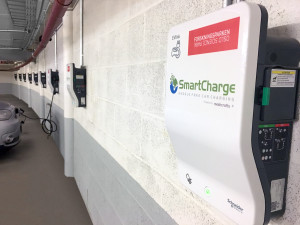E-Mobility Solutions and the Future of Transportation: Q&A with Paal Christian Myhre
on
Competition in the e-mobility (electro-mobility) solutions market is heating up. Meshcrafts CEO/Co-Founder Paal Christian Myhre believes e-mobility is the future of public and private transportation. He talks about the future of the industry as well his company's innovative products.
The Electromobility market
C. J. Abate: What’s the story behind Meshcrafts. Why did you launch the company in 2013?
Paal Christian Myhre: The initial idea behind Meshcrafts was developed by Åsmund Møll Frengstad in a student project at the NMBU – The Norwegian University of Life Sciences. Based on this idea and winning a start-up competition, the company was established at the end of 2013 with the support of Inven2, a Norwegian equity fund focusing on startups.

(CEO/Co-founder von Meshcrafts)
C.J.: How has the e-mobility market changed since 2013?
Paal: The e-mobility market has made giant steps since 2013 when Meshcrafts was founded. Earlier, the e-mobility market was dominated by smaller cars, like Buddy, Think, and Reva – not really cars anybody considered as “real” cars suitable for the everyday use of families, commuters, etc. However, the first changes came with the introduction of the Nissan Leaf and then the Tesla Model S, the first full-size electric car. In the last years, we have seen several car producers moving into the e-mobility space with new models, changing the market into a more mature market – especially in the market for small cars and shorter distances. The trend is now into electric cars with the capability of replacing fossil fueled cars in all market segments.
The first cars were charged on normal household sockets. Due to this, our focus from the start was on hardware with an IoT solution controlling electrical sockets used for charging of the cars. With the increase of electric cars on the market and their extended range and larger batteries, the need for dedicated chargers (Figure 1) developed with several hardware producers delivering chargers. Meshcrafts has since the start been part of the Open Charge Alliance (OCA), the organization developing the standards for charging and is contributing to the roll out of intelligent charging infrastructure for the new cars and markets.

Meshcrafts software
C.J.: Is Meshcrafts solely a software company?Paal: Today, Meshcrafts’s focus area is software for controlling charging infrastructure in the perspective of energy management for all stakeholders in the e-mobility space. Our software, SmartCharge, gives the owner of a charging station full control of the charging on the station with payment, measurement, predictive charging and maintenance, etc (Figure 2). The load on the chargers are also monitored and balanced in accordance with available effects and the load on other power users in the grid, making the EV-charging an integral part of the energy flexibility market.

.
C. J.: Describe your business model?
Paal: The software is delivered to our customers on a Software-as-a-Service plan with a monthly subscription on the points active on our SmartCharge platform. We also sell the SmartCharge solution as a Platform-as-a-Service to larger entities controlling larger nets of chargers (e.g., petrol stations operators).
C. J.: How do you monetize? What are your Basic, Advanced, and Premium plans?
Paal: In addition to the monthly subscription fee on the points controlled by the platform, Meshcrafts charges a fee on the turnover for the payment services and a cut on the saving made by the infrastructure owner by using the platform. The different plans are a function of the service and feature level wanted by the users of the platform.
E-Mobility in Europe
C. J.: Tell us about your market and customers.
Paal: Our focus market has been Norway, both as a home market and of course it being the market with the highest penetration of worldwide. This makes it an ideal sandbox for developing solutions for the electric cars with a “real,” live market for testing. The next market we focus on is Germany, the market with the highest growth of the EU countries. Our customers in the different markets range from owners and operators of parking lots offering charging on their lot via fleet operators of electric cars to municipalities and power companies. The fastest growing customer group in Norway is apartment buildings with garages where cars are charged overnight.
C. J.: How popular are electric vehicles (EV) in Norway? Is EV technology more popular in Norway than it is in the other Scandinavian countries? What about compared to the rest of Europe?
Paal: Norway is by far the market with the highest uptake on electric cars. 23% of the electric cars sold in Europe so far in 2018 were delivered in Norway, while Norway accounts for less than 1% of the total European car market. We expect this will change drastically the next years with several new car models entering the market and the prices for electric cars going down. As an example, in Germany it is now for the first time on a monthly basis sold more electric cars than in Norway. And other markets are following suit.
C. J.: How many charging stations do you track in Norway? Are you in other countries?
Paal: We have close to 1,000 charging stations on our platform now, the majority in Norway. We have some installations in Germany as well and will open the first chargers in other EU countries in the next months.
Smart E-Mobility Solutions
C. J.: Describe your Smart Urban Mobility platform. Tell us about the four modules: Smart Charge, Smart Park, Smart Point, and Smart Charge EV.
Paal: Our platform is developed with the different challenges for urban mobility in mind. Our focus from the start has been on the charging infrastructure. With Smart Park, we aim to optimize the use of available parking areas, minimizing the in-city traffic and in turn cutting CO2 emissions. Smart Point is developed for controlling other power outlets than the charging box for electric cars and with the same focus on energy management. In e-mobility, we also include busses, ferries, ships, smaller boats, and later also planes. All these modes of transportation should be integrated into an eco-system handling the energy needs. The SmartCharge EV is our app used by electric car drivers to navigate to chargers, pay for charging, route planning, etc.
C. J.: What makes your solutions different than others on the market?
Paal: The SmartCharge platform is an open market place connecting e-mobility and energy with a broader perspective on energy management for all stakeholders in the e-mobility market from the driver and the owner of the charging station to the grid owner and the DSOs. With the expected uptake of electric cars combined with the increased use of renewable energy, management of the energy to optimize the use of the different stakeholders’ resources gives a higher ROI and lowers costs and investments.
C. J.: What will happen a few years down the road when autonomous driving gains more traction? Will a rapid increase in autonomous driving vehicles on the road pose a threat to your business?
Paal: Autonomous cars will most likely be electric cars and hence need charging as well. However, the charging of these cars must be planned and optimized to make the cars capable of driving when they should. We see this as an opportunity for us, delivering services and solutions to the operators of these cars making sure they are sufficiently charged at all times.
C. J.: What has been the most difficult aspect of launching and running a startup?
Paal: Launching a startup is not that difficult. The follow up is the hard part. With limited resources, you have to build a diverse team capable of handling all the different tasks of an organization. In most cases the team members have to cover several areas, hence have or build broad competences and with little time for specialization. Getting the first customers on board at the same time as developing the platform, attracting investors, and seeking other sources of funding is time consuming and hard work. Focus on the tasks that brings the company to the next level is essential and takes hard prioritizing of the resources.
The Future of E-Mobility
C. J.: What’s next for Meshcrafts? Where do you see the company in 12 months?
Paal: Meshcrafts seeks partners and investors to move into new markets to build a market presence and contribute to the building of infrastructure for e-mobility. In 12 months, Meshcrafts is established as a major player in Germany and have installations in several other European markets, possibly also in some Asian countries.
C. J.: What are your thoughts on the future of e-mobility?
Paal: We firmly believe e-mobility is the future for transport, both public and private. As an old “petrol-head” with a passion for cars, I am confident I will never again buy a fossil fueled car to cover my transportation needs. I am also very much looking forward to the autonomous cars taking care of the transport from A to B. As a passionate driver, I will not give up driving but enjoy the active part of driving on tracks and on tours.
This article also appeared in the November 2018 edition of Elektor Industry magazine.


Discussion (0 comments)